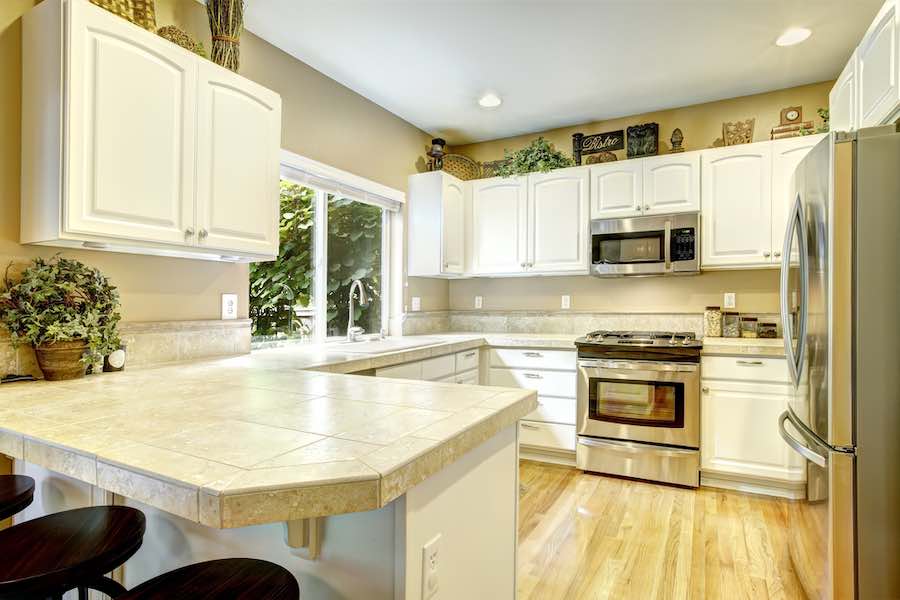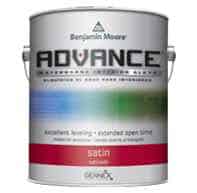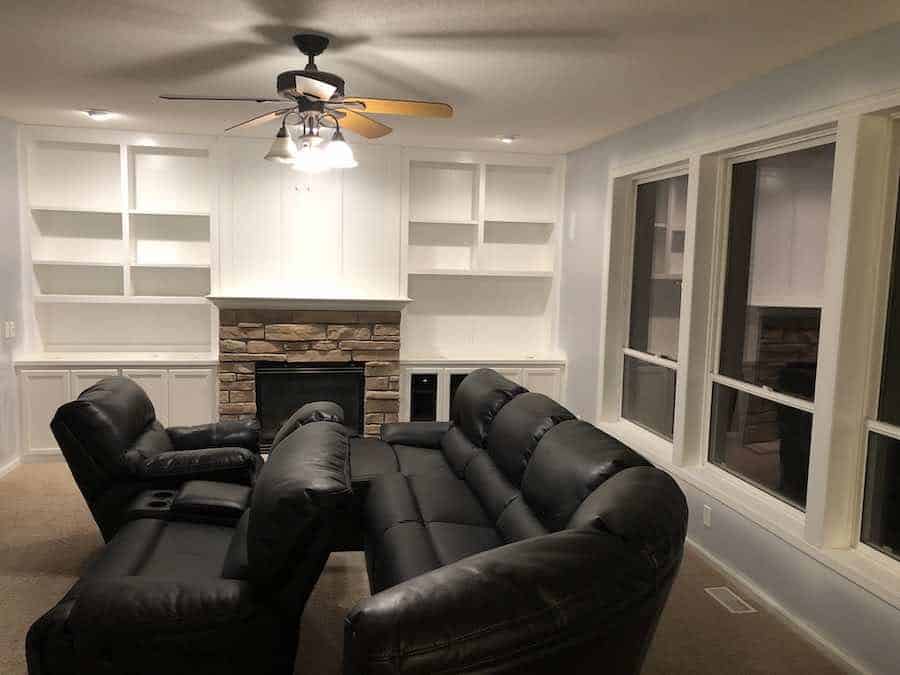Benjamin Moore Advance Interior Satin Paint Kitchen Cabinets
Benjamin Moore Advance came onto the market roughly 6 years ago as an answer to the gap between oil and water-based enamels.
Since that time Advance has become popular both with painting contractors and homeowners for its unique properties.

But is Benajmin Moore's Advance what you should be using on your kitchen cabinets? Let's dive in and find out.
What Is Benjamin Moore Advance

Traditionally oil-based enamels such as Benjamin Moore's Satin Impervo have been the best quality paint for kitchen cabinets, windows, trim, doors, and furniture.
Oil-based paints are alkyd based use harsh solvents as a carrier, thus making them high in VOCs and odors.
Oil-based paints do have a beautiful finish, they dry hard and durable, have great adhesion, they flow beautifully (self-level), and are easy to apply. The problem, however, is that they have a high VOC content, high odor, cleanup requires solvents, and dry time is over 24 hours.
By contrast, latex (water-based) enamels were easy to clean up, have low odor, lower VOC content, and dry much faster. This is because their carrier of the pigments in latex paint is water.
However, latex paints/enamels lack the quality finished look of their oil brethren, don't flow as well, and have lower adhesion. Durability is typically acceptable.
This left a gap in kitchen cabinet paints and Advance was Benjamin Moore's solution.
Benjamin Moore's Advance is a low VOC Water Reducible Alkyd. This means that Advance is an alkyd that uses water as a carrier instead of solvents.
In theory, this gives us all the benefits of an oil-based alkyd without any of the negatives. They are basically combining the benefits of oil and water-based enamels into a hybrid enamel.
In theory, Benjamin Moore's Advance has a great finished look, flow, adhesion, durability and cleans up with water instead of solvent, has low odor and VOC, and even dries quickly.
Our Ratings
| Category | Rating |
| Flow | ★★★★ |
| Durability | ★★★★ |
| VOC Content | ★★★★★ |
| Adhesion | ★★★★ |
| Sprayability | ★★★★ |
| Brushing | ★★★ |
| Dry Time | ★★★★ |
| Cleanup | ★★★★★ |
| Price | ★★★★ |
| TOTAL | 37/45 |
Advance Specs
| Specs | |
| Carrier Type: | Waterborne Alkyd |
| Volume Solids: | 39.0% |
| Dry Time Touch: | 4 Hours |
| Dry Time Recoat: | 16 Hours |
| Coverage / Gallon: | 400-500 Sq Ft. |
| VOC Level: | 48 |
First Thoughts Of Benjamin Moore Advance
I've been a painting contractor for nearly 20 years.
Back in 2012 I shifted my business and focused heavily on refinishing and painting kitchen cabinets. Since that time I have painted over 100 sets of kitchen cabinets and developed a unique system that gets great results.
You can read more about painting kitchen cabinet here.
Enameling kitchen cabinets with oil-based paint worked. I was able to get a great looking finish and great results.
However, the homeowners often had to leave their house during the entire process, I had to buy and dispose of solvents for thinning and cleanup, and after years of breathing in high VOC levels, I began worrying about my own health.
This is when I was informed of Advance.
I immediately thought that the concept was too good to be true, so I had to try it out for myself.
Right off the. bat, I love not having to purchase paint thinner for reduction and cleanup.
Next, I love that I don't need to cover my body like I did when spraying oil. Since oil dries so slow, the droplets of overspray in the air could literally stick to things across the room, so I would always be covered in overspray. I would wear a complete spray suit, mask, earplugs to protect access to my brain, eye coverings (anything that has easy access to my inner workings, I protected).
With the main benefits of safety and cleanup realized, I needed to know if Advance sprays well, brushes well, flows and levels, adheres, has long term durability and does it pass the eye test?
I'll cover each one of these individually in more detail.
Odor / VOC
Benjamin Moore's Advance has a lower VOC content that typical alkyd based paints.
This is due to the. fact that its carrier is water and not a solvent.
For comparison, here are Benjamin Moore's 3 most popular enamels and their respective VOC contents.
- Oil Based Impervo = 375 grams / liter
- Water Based Impervo = 135 grams / liter
- Advance = 47 grams / liter
*NOTE: Low VOC is considered less than 250 grams/liter.
Spraying Benjamin Moore Advance
When I spray kitchen cabinets, I use an HVLP sprayer, which is a High Volume Low Pressure sprayer (I use a Titan Capsray 115).
You can read all about HVLP paint sprayers in my post The Best Paint Sprayer For Every Painting Project .
HVLP sprayers typically require thinner paint than airless sprayers, so I thin Advance down with 20% water before spraying. For me, 20% is the perfect spot to get the paint just thin enough to produce a fine mist when spraying.
I find that Advance sprays really well with my HLVP. It has a really nice flow and lays flat for me. It atomizes really well with the HVLP and I can honestly say that it sprays about as well as any water or oil-based paint that I have sprayed with an HVLP sprayer.
Brushing & Rolling Benjamin Moore Advance
I recently enameled all of the woodwork on the main level in a house using only Advance. I used both their primer and satin topcoat. This included kitchen cabinets, windows, doors, trim, and built-ins.
I sprayed the kitchen cabinets and doors to get a nice glassy look, but I used a brush on all of the base trim.
I find that Advance brushes quite nice with a fine bristle brush. It does tend to form runs quite easily though when brushing. I needed to go back and check my work every 10 minutes or so to make sure that no runs had formed.
Surprisingly, I didn't experience any runs when spraying. Brushing tends to create heavy spots easier than spraying, which causes the runs.
I would be perfectly happy brushing Advance on doors, trim, or windows in my own home.
TIP : When brushing enamels such as Advance, make sure to use as high-quality brush as possible. A fine bristle brush will lay the paint on smooth and allow it to flow better into an even finish.
Benjamin Moore Advance Dry Times
While the technical specs of Advance say that it dries to the touch in 4 hours and can be recoated in 16 hours, I found that in reality, it dries much faster.
Assuming the humidity in the area you are painting is relatively low, Advance can be dry to the touch within an hour, similar to any water-based paint.
Sanding and re-coating typically takes a bit longer. I've found that I can sand and re-coat Advance usually after 3-4 hours.
Cure Times
Curing is different from drying. A cured paint refers to when it has reached it maximum hardness. Most paints typically take anywhere from 7-30 days to be fully cured.
In the real world, a fully cured paint means you won't be able to easily scratch it. It has reached its maximum durability.
Advance says it can take up to 30 days to reach maximum hardness (full cure), I have found this to be true as well.
Advance Primer and Top Coat Sanding
The ability to effectively sand a primer and topcoat is important, especially when you're trying to achieve perfectly smooth cabinet doors.
I have found that Advance primer sands and powders decently. Not as good as some oil-based sanding primers, but good enough to achieve a smooth primed surface.
Advance topcoat doesn't sand as well as the primer, and it shouldn't, but light sandings between coats worked really well and allowed for a perfectly smooth finish before spraying and brushing the final topcoat.
Touch Up
The ability to touch up an enamel is important. No matter how good of a job you do, you will eventually need to touch up your painted cabinets.
Some enamels touch up terribly. If you try to fix small areas, they stand out like a sore thumb.
I have found that advance touches up quite nicely. Small touch-ups typically blend in within 24 hours and are not noticeable in less prominent areas.
Long Term Durability
The fact that Benjamin Moore's Advance goes on smooth and has low VOC content is great and all, but what about its long term durability? Will it last in your home with kids, pets, and every day use?
I can only half answer this question.
I do not have my kitchen cabinets enameled with Advance. However, I have probably used Advance on over 20 of my client's kitchens in the past 5+ years.
Of those roughly 20 kitchens I have painted with Advance, I have received zero callbacks.
If Advance didn't hold up well and chipped, scratched or marred easily, I would expect a high number of callbacks, especially to homes with kids and pets.
Benjamin Moore Advance Price & Where To Purchase
You can. typically purchase Benjamin Moore Advance for about $55. If your local store is selling it for more, then they are high. Many paint stores run lots of different sales, so you may even find it cheaper.
You can buy Advance at any paint store that is a dealer of Benjamin Moore products.
You can read product data sheets and more here.
Where You Should Use Benjamin Moore Advance
I recommend using Advance in any home where people are currently occupying the home during the work.
If you plan on painting your cabinets while living in your home and don't want to deal with odors and dangerous VOC levels, then Advance is perfect.
It is also great for painting contractors who must work in occupied homes as well.
Advance is great for any areas where you need a hard durable finish such as kitchen cabinets, windows, doors, trim, built-ins, and furniture.
Tips on Using Advance
- If spraying, thing Advance using clean water by 10-20%.
- If brushing, use a high-quality fine bristled brush.
- Allow Advance to cure a minimum of 7 days before high usage.
- If rolling, use a velure cover for a smooth even finish.
- If brushing, pay attention and look for runs.
Final Thoughts

If you look around online, you can always find people who dislike any product. The same is true for Advance.
But, when used correctly, Advance is a great product that fills the gap between oil-based enamels and water-based enamels perfectly.
You will have durability and adhesion issues with any paint if you do not properly clean, prep and prime the area, so make sure to take your time and don't skip the prep work.
You can read more about prep work for painting here.
At the end of the day, Advance has become my go-to enamel when painting kitchen cabinets, doors, windows, and furniture.
Its ease of use, great finished look, low VOC and easy cleanup make it a product that I happy to use and will continue to use for a long time.
Benjamin Moore Advance FAQ
Can You Spray Benjamin Moore Advance
Advance can easily be sprayed using an airless or HVLP sprayer. When using an HVLP, you may need to thin the paint by 10-20%. Airless sprayers will not require thinning.
Can You Brush Benjamin Moore Advance
You can use a brush and/or roller when applying Benjamin Moore Advance. Make sure to pay attention for runs as they happen frequently when brushing.
How Lond Does Benjamin Moore Advance Take To Dry
In a low humidity environment, Advance can take anywhere from 30 minutes to 2 hours to dry to the touch. Expect 4-6 hours of dry time before you can sand and recoat.
Is Benjamin Moore Advance Durable
Yes. Advance is a durable enamel paint perfect for kitchen cabinets, doors, windows, trim, and furniture.
Benjamin Moore Advance Interior Satin Paint Kitchen Cabinets
Source: https://diypaintingtips.com/benjamin-moore-advance-cabinet-paint-review/